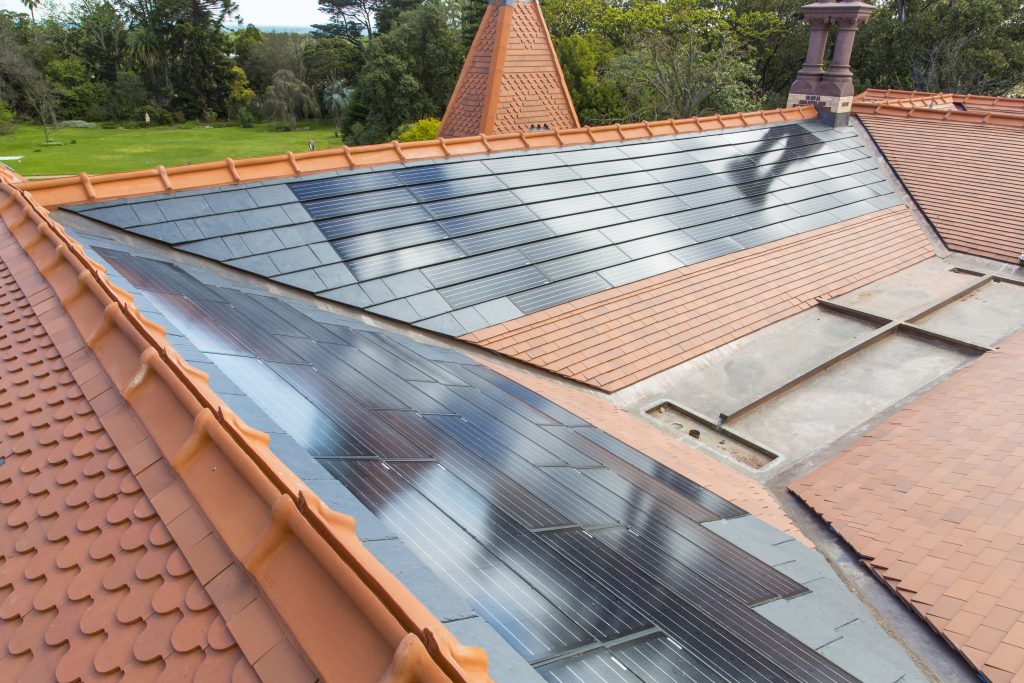Solar panels: yay or nay?

Two recent but unrelated articles about solar panels on heritage buildings in inner Melbourne highlight the vexed and confusing approach of heritage towards this contemporary energy solution.
In early September, the Northcote Leader reported that the Westgarth Theatre had 156 panels installed, spelling out ‘PALACE’ when seen from Ruckers Hill. On the corner of Barry and High Streets, it was built in 1921 as a cinema, although the ‘talkies’ didn’t arrive until 1929. It was classified by the National Trust in 1994, as an early example of a cinema building constructed in a decade of unprecedented growth in the motion picture industry, and for its ongoing contribution as a niche cinema venue in the 2nd part of the 20th Century. Architecturally, the former Westgarth Theatre is a significant example of the cinema buildings of the 1920s with its classical motifs, and is notable for its interior decoration, in particular the geometric detail of the entrance vestibule and stairs to the mezzanine section.
The new panels will provide the cinema with 40% of its power needs. “This is the first one but we’re planning to do the same thing with our other cinemas with appropriate roof space and orientation,” said Palace Cinemas Chief Executive Benjamin Zeccola. He said the Astor Theatre in St Kilda was a good candidate for solar.
The new roof feature seems to have been well-received by locals. “Iconic signage from any era really creates a legacy for the precinct — we see old brands and products adorning the walls of bygone milkbars and small businesses all over the inner city… I’d like to think this positive moment in the early 21st century with so many of us transitioning to sustainable power generation, will still be gazing down on High St a century for now on a much loved reminder of the past for locals of the future,” said Merri Community Group convener Mike Flattley.
Meanwhile, Domain.com.au reported a Parkville resident failed to obtain a permit for the $6000 solar panels installed on the north-west facing roof frontage. Under a heritage overlay, a permit is required for “a solar energy facility attached to a building that primarily services the land on which it is situated if the services are visible from a street (other than a lane) or public park”.
City of Melbourne refused a retrospective planning permit application, arguing that the solar panels:
- disrupt the uniformity of distinct Victorian era housing in the street and the appreciation of the building’s architectural features when viewed from the streetscape
- have an adverse effect on the heritage significance of the building and place
- draw attention away from the contributory features of the dwelling
- are not respectful and detract from the architectural and historical character of the place and streetscape.
The citation for the building describes a “two storey row house with fine rendered details to parapet and wing wall, typical for its period. Notable features include verandah decoration, verandah roof and structure, and elaborate/high design of cement rendered surfaces.” The building is in a Level 1 Streetscape, which is the highest order under the Planning Scheme and presents a cohesive group of Victorian period buildings in a heritage streetscape.
At VCAT, the owner contended that:
- consideration should be made of the environmental benefits of renewable energy;
- the solar panels are less obtrusive than the concrete roof tiles that they cover, and similar in colour to slate roofing; and,
- the panels are only slightly visible, not being noticeable by passing drivers and partially screened from view from Royal Park by trees.
VCAT upheld the Council’s decision that no permit should issue.
City of Melbourne Councillor Aaron Wood said he has now called for a review into how the planning scheme relates to solar. He said the case highlighted the competing interests created by both a push for renewables and heritage in the area.

The National Trust is supportive of making heritage buildings environmentally sustainable and, in most places, it is possible to integrate solar technology without compromising heritage values. In 2013, the National Trust installed solar panels on the roof of Rippon Lea House, making it the first National Trust property in Australia to use solar power. The panels on Rippon Lea are nestled on the inside of the roof valley, making them hidden from every angle except a bird’s eye view. The solar array was installed as part of a roof restoration project that saw the original terracotta roof design reinstated, replacing the heavy, ugly grey concrete tiles put on in the 1950s. National Trust CEO Martin Purslow said Sir Frederick Sargood, who owned Rippon Lea in the 19th Century, would have approved.
”Sargood was very innovative and into new technology, if he was around now this sort of thing is what he would be doing.”
 Pictures: Westgarth Theatre – Josie Hayden / News Ltd; Gatehouse Street terrace – Simon O’Dwyer / Fairfax Media.
Pictures: Westgarth Theatre – Josie Hayden / News Ltd; Gatehouse Street terrace – Simon O’Dwyer / Fairfax Media.

+ There are no comments
Add yours